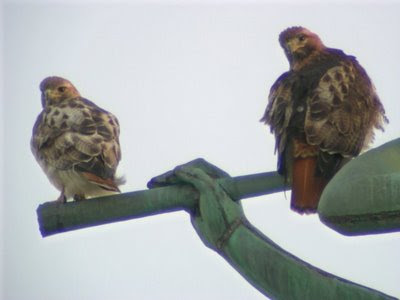
My daughter Samantha, her friend Ryan Patrone, and Hawk Watcher Ludie Stern, went to Central Park today in search of birds with Red-tails.
They discovered a number of Blue Jays,

numerous Blue-bar Pigeons,
and even an intermittently blue sky above 927 Fifth Avenue, a rarity these days.
And to their complete surprise they discovered that the Model Boat Pond which had been flush with Mallards just two days ago, had been drained for it's yearly repair and cleaning. Not to fear, the Mallards had just relocated to The Lake across the road but it was still a little startling to the humans unused to the artificiality of Central Park's bodies of water.

In case things seemed too strange, there was the comfort that the pigeon flock was still alive, well, and circling as usual

There was the nest perched atop the cradle, perched atop the cornice, and waiting for a couple of birds with Red-tails to set up housekeeping. Resident Hawk Bench photographer Rik Davis, explained that Lola had just left a perch over on the Oreo, but currently was nowhere in sight.
Now isn't that typical?

Samantha took off to check possible perches.

Ryan manned the Swarovski Scope, Ludie looked for a certain pair to photograph, but all to no avail. Not today any way. If it were all that easy, it wouldn't be nearly as much fun when they did appear.
But as Scarlett O'Hara so aptly says, "Tomorrow is another day."

Alex
Courtesy of The Alex Foundation
http://www.alexfoundation.org/index.htmWashoe
Courtesy of Central Washington University
And a beautifully written piece by Charles Seibert, well worth reading, concerning the passing of Alex the African Grey Parrot and Washoe, the Chimpanzee, in their traditional end of the year New York Times Magazine, The Lives They Lived.
THE COMMUNICATORS
Alex b. 1976
"THERE IS, IN THE END, no telling what tales they had to tell, the two greatest nonhuman linguists of our day: Washoe, the sign-language-wielding chimpanzee with an intense footwear fetish; and Alex, the wildly outspoken parrot, an African gray known to regularly order about his human researchers and to purposely give them the wrong answers to their questions just to alleviate his boredom. After all, we only ever gave them our own words to work with."
I noted that the second sentence of the introduction in The Lives They Lived said, "On the last Sunday of each year, we fill these pages with stories of all kinds of people who have died during the last 12 months."
What's that they said,"...with stories of all kinds of people"? Just as a young child who begins to speak becomes more of a person to us, so too these intra-species talkers became, well no, not human exactly, they aren't Homo sapiens, but rather "people", people of another species, by learning our language. And in a gentle obscure way The York Times respected them enough to include them and say, that they were "people" too.
Donegal Browne



































